John Hurrell – 14 April, 2010
This year with this event the much anticipated new space, Shed 6 is so depressing in its lack lustre spatial organisation, broken equipment and generally dull content that (I'll confess) looking over themes in general is a more buoyant and evasively positive method of discussing the displays.
Various Venues
Last Ride in a Hot Air Balloon
Part Three: The Imagination
Bundith Phunsombatlert, Gerard Byrne, Tom Nicholson, Tove Storch, Walid Sadek, Philippe Parreno
12 March - 20 June 2010
With the various international Biennales and Triennials that most of us are familiar with, when faced with the daunting task of reviewing such large shows, most writers tend to examine the exhibited art venue by venue and work their way through one address at a time. However this year with this event the much anticipated new space, Shed 6 is so depressing in its lack lustre spatial organisation, broken equipment and generally dull content that (I’ll confess) looking over themes in general is a more buoyant and evasively positive method of discussing the displays.
The theme of the imagination is a more prevalent aspect than what initially it might seem. The most obvious demonstration is found in the kinetic sculpture of Bundith Phunsombatlert, located in a narrow corridor-like space upstairs in The New Gallery. His contribution becomes apparent when the wandering visitor triggers an electric eye and various perches start swinging as if a bird has taken off. We never see such a bird but we do detect its moving presence as it flies from perch to perch and squawks above our heads.
By positioning the perches at heart height the artist brings the imagination, emotions and intellect together. The work is corporeal in the sense that the swings’ movement at chest height spark off a visceral empathy - we are startled as well as amused. And almost assaulted. We can figure out technically what the artist is doing but our mental facilities also generate an exotic creature with which we can playfully fantasise in terms of its appearance and why it might exist.
Gerard Byrne’s installation deals with the media coverage of the Loch Ness Monster, examining the history of the sitings, the language of the descriptions, and the cultural rise of newspapers and television. The audio readings of ‘field observations’ from printed matter, enunciated in a thick Scottish accent, bring a sardonic humour that is a vivid foil to the relentlessly dry visual presentation. Consequently I greatly enjoyed the audio but found the visual material too clinical. It was the smart-aleckly male reader of the texts that gripped my imagination, not whether a floating stump might be mistaken for Nessie’s head or if a ripple from a boat created the back of a Plesiosaur.
Tom Nicholson’s account of the deaths of Australian explorers Burke and Wills is fascinating reading, showing a vivid example of colonial stupidity where their racism assisted their own demise. Positioned on screens in the shed at an awkward angle, with a sound system set up on an odd little stage adjacent to a sequential line of images and text, it is the outer large image of waving red warning flags that grips - not the sound track. That and Nicholson’s notion of a flood in Melbourne one day causing the flowering of red nardoo in Royal Park to create a true memorial. The explorers were starving when they ate the sporocarps of the plant, ground into flour and made into cakes, but they died anyway - for the sporocarps remain indigestible and innutritious unless roasted a certain way. Burke and Willis scared off and abused the Aboriginal people who ate the plant and who could have saved them.
The freestanding sculptures of Tove Storch attempt to lure the imagination into interpreting the ambiguous shapes inside translucent vitrines of engraved silicone lined with varnish. These tall vertical, rectangular containers have walls that, appearing initially to be frosted glass, vary in opacity according to where you stand in relation to the natural light pouring in through the skylights. However they are not sufficiently compelling to make you want to stick around and puzzle over what is partially hidden. They lack genuine mystery, for Storch’s determined attempts to be super-subtle end up making them lack-lustre. Her technical wizardry falls flat.
Walid Sadek’s contribution is a walled-off shrine that contemplates the life of the only surviving terrorist of the 1972 Lod Airport massacre in Tel Aviv. Kozo Okamoto, then a member of the Japanese Red Army, now lives in Lebanon after being released by the Israelis in 1985. Sadek’s minimal space, with a circular pencil drawing on the floor and carefully prepared wall labels, has a nice meditative feel to it - being a understated reference to prison confinement and the ability of the imagination to transcend physical barriers. I’m not sympathetic to Okamoto at all - he’s a cold blooded murderer - but I found Sadek’s austere installation quietly moving.
Philippe Parreno for The New Gallery, provides an dazzling bulb-lined entrance, a sort of glowing burlesque lintel or pediment that visitors pass under, and which suggests the Triennial is a huge sideshow. It is a shame he didn’t create several of these for all the venues, for then his project would make much more sense and not favour Auckland Art Gallery as a site. Its exuberant razzamatazzy mood doesn’t really match the ambience of the total event which is much more subdued and anti-celebratory. His work is far too uplifting, optimistic and joyous for this show.
The next part of my thematic Triennial discussion - the fourth - will look at The Economy.
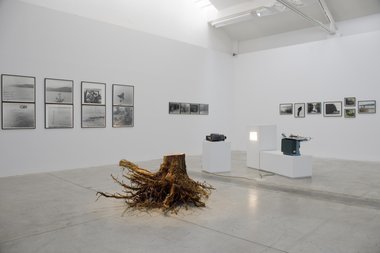
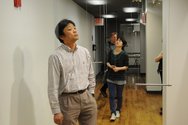

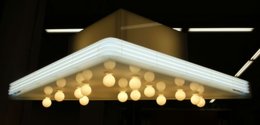
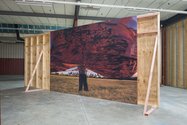


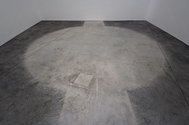
 Advertising in this column
Advertising in this column Two Rooms presents a program of residencies and projects
Two Rooms presents a program of residencies and projects



This Discussion has 0 comments.
Comment
Participate
Register to Participate.
Sign in
Sign in to an existing account.